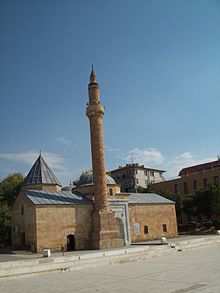Ahi Evran
You can help expand this article with text translated from the corresponding article in Turkish. (October 2021) Click [show] for important translation instructions.
|

Sheikh Pir Nasiruddin Abul Hakayik Pir Mahmud bin Ahmed Ahi Evran bin Abbas Veli al-Khoyi (1169–1261), commonly known as Ahi Evran or Pir Ahi Evren-ı Veli, was a Turkic Alevi Sufi saint, preacher, philosopher and poet who wrote 20 books. He is mostly remembered as the founder and leader of the Ahi Brotherhood.[1]
Life
[edit]Born in Khoy, Iranian Azerbaijan in 1169,[2] he moved to Kayseri, Turkey and established the Ahi guild there.[3] He was skilled in the leatherworking trade and he organized guilds from 32 different professions. He led and organized the Ahis into a force capable of fighting the invading Mongols.[1]
He was a Bektashi preacher who had gone to Trabzon during the Empire of Trebizond to spread Islam. As a scholar, he was taught by teachers in Baghdad and Khorasan.[1]
He was killed by Mongols in Kırşehir on 1 April 1261. His grave site is in debate, but thought to be in Boztepe. The site is near Trabzon. It is considered as sacred and has been visited by many people. This grave, however, may instead be that of a clan leader or a Greek metropolitan who had accepted Islam. According to Şakir Şevket, in 1863, Muslim preacher Sheykh Haji Hakki Efendi was inspired to build a place near Ahi Evren's grave. So when Sheykh Haji Hakki Efendi died in 1890, he was buried there. The government then built a tomb and mosque at the site.
Legacy
[edit]
A new insect species discovered in Turkey by assistant professor Mahmut Erbey at Ahi Evran University was named Evrani to honor the university and the saint.[4] An annual festival is held in Kırşehir, where its organized by the local chambers of commerce.[1]
A museum in Kayseri, the Ahi Evran Esnaf ve Sanatkarlar Müzesi , is dedicated to his influence on traders and craftsmen.
See also
[edit]References
[edit]- ^ a b c d Darke, Diana (2022). The Ottomans: A Cultural Legacy. Thames & Hudson. pp. 86, 88. ISBN 978-0-500-77753-4.
- ^ Mikail Bayram, Ahi Evran ve Ahi Teşkilâtının Kuruluşu, Konya 1991, s.135
- ^ Salih Özkan, Türk Eğitim Tarihi, Nobel Yayım Dağıtım, 2.basım Mart 2008, s.44 ISBN 978-605-395-089-9
- ^ sabah, daily (17 August 2015). "New insect species registered in Turkey". Daily Sabah. Retrieved 30 November 2021.
Sources
[edit]- Öztürk, Özhan (2005). Karadeniz : ansiklopedik sözlük (1. basım ed.). İstanbul: Heyamola Yayınları. ISBN 975-6121-00-9. OCLC 63737636.
- "Alevi Önderleri (Horasan Piri Hünkar Hacı Bektaş Veli) |". 26 April 2017. Archived from the original on 26 April 2017. Retrieved 30 November 2021.
- "Haci Bektas Veli and Bektashi Order | All About Turkey". www.allaboutturkey.com. Retrieved 30 November 2021.
- "Traditional Institutions - Dervish Orders". www.ktb.gov.tr. Retrieved 30 November 2021.
